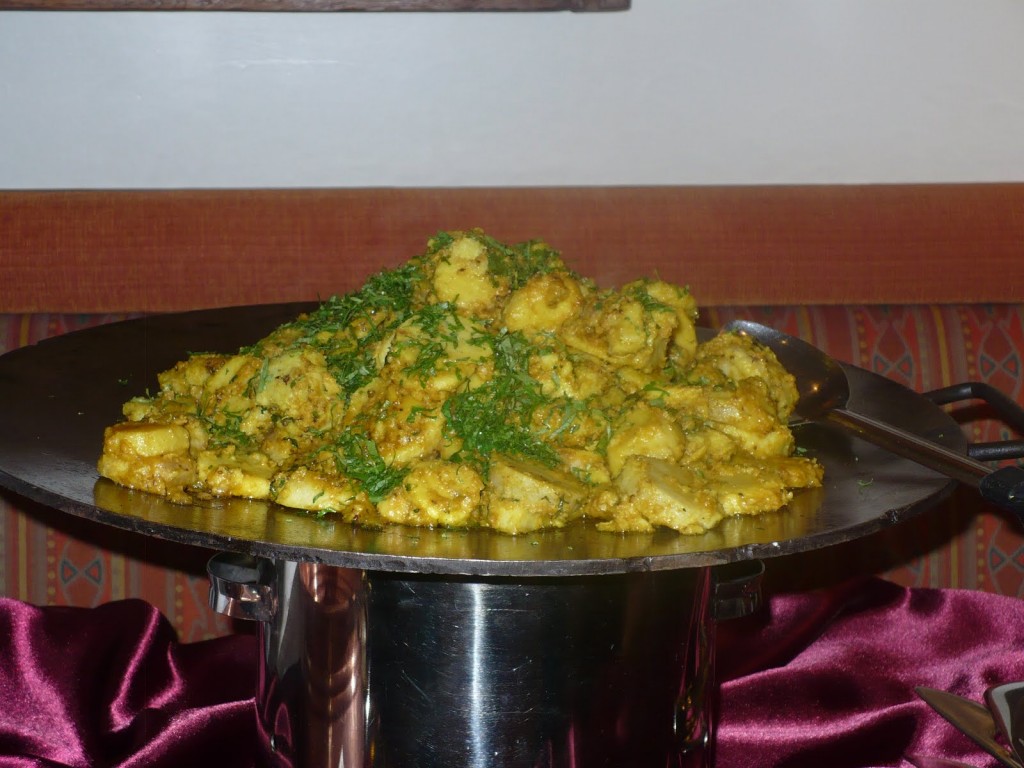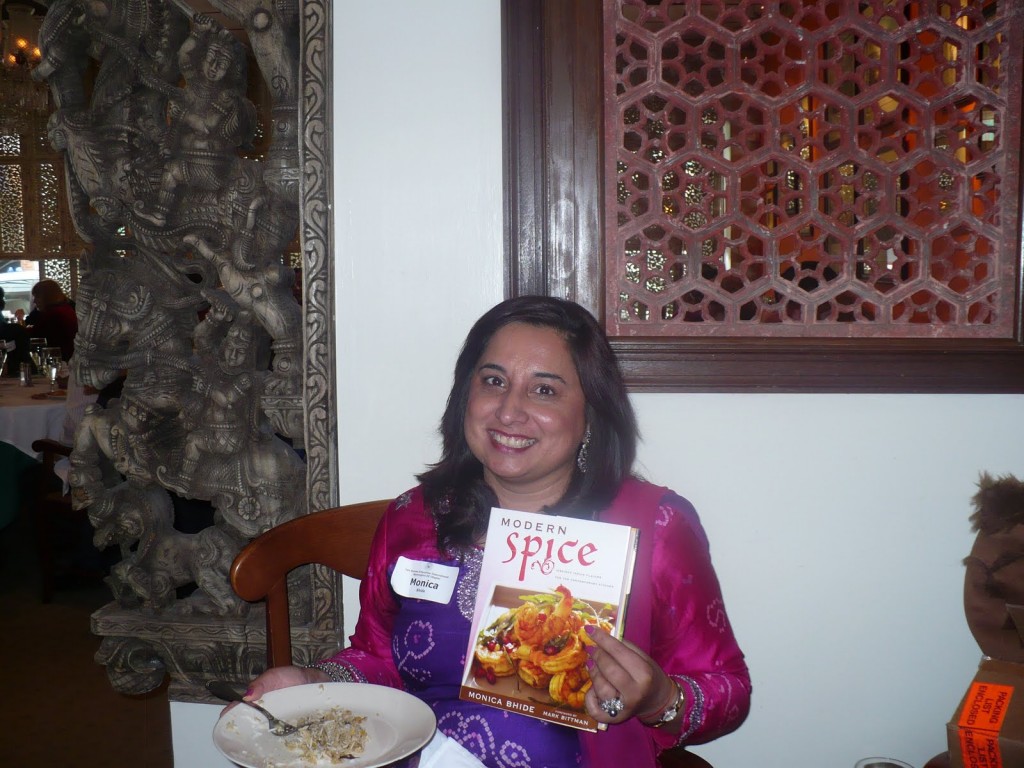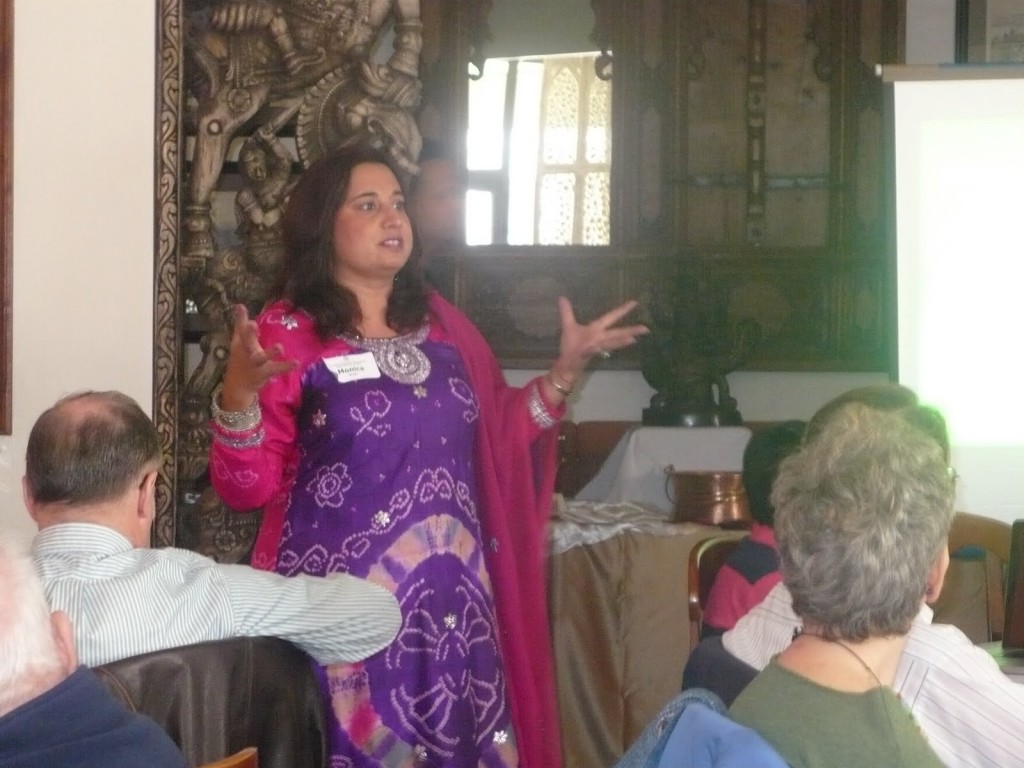By Devika Koppikar

pudding made from equal parts of butter, sugar and flour.

Bethesda, MD – Food writer Monica Bhide had cooking “cultural shock” when she saw a French chef in action earlier in her career.“While cooking, he took his finger, put it in the sauce and tasted it,” shared Bhide to a crowd of food connoisseurs at a recent presentation in Bethesda. “Growing up in a Hindu household, we never tasted food while it was being prepared because we presented it to the gods first.”Thus began Bhide’s interest in the role of religion in preparing, serving and consuming Indian food. Now a well-established and nationally-known food writer, Bhide lectured about the “Sacred Foods of India,” at the March 3 seminar and luncheon sponsored by the Les Dames d’ Escoffier, a professional organization of women in the food, beverage and hospitality fields.
With a 5,000-year-old history, several religions and cultures, “a lecture on ‘the Sacred Foods of India’ would take five years,” said Bhide, “The traditions are amazing and it blew my mind.”
Inspired by Bhide’s expertise and passion, we are presenting a look at the intersection between food and religion in Sikhism and Hinduism.
“Sacred foods are foods that have been sanctified…. in some shape of form, the food has been prayed over,” said Bhide.

Sacred Foods of Sikhism:
“All foods are sacred if prepared with love and reverence,” said Guruka Singh, CEO of SikhNet, a worldwide website, that provides news and information for followers and seekers of the Sikh religion. “It is considered sacred because it is prayed and chanted over and it is prepared with joy.”
Central to the Sikh faith, is the concept of the langar, or free kitchen at the gurdwara (temple), where everyone is served vegetarian food and sits side-by-side to eat a simple meal, Singh said.
Ravilnder Khalsa, a member of the Raj Khalsa Gurdwara in Sterling, VA added, “The langar is designed to uphold the principle of equality between all people of the world regardless of religion, caste, ethnicity, creed, age, gender or social status. In addition to the ideals of equality, the tradition of langar expresses the ethics of sharing, community, inclusiveness and oneness of mankind.”
Similar to Bhide’s family tradition of not tasking food while in preparation, Khalsa said, “Strict rules of hygiene and cleanliness are important when preparing the langar – for instance, washed hands, never tasting it while cooking, excusing yourself of service when you’re in poor health. In addition, we often chant banis, mantras, or shabads (special prayers) during the meal preparation. Finally, we bless the meal during the community prayer or ardass near the end of the gurdwara program.
As for actual food items, Singh said that the langars serve only simple, vegetarian food mainly to include all people and for health reasons.
“This means no meat, fish, or poultry. Rather, we serve foods that are easily digestible like dhals (lentils), yogurt, salad, roti (bread).”
Finally, before visitors or worshippers leave the gurdwaras, they receive a handful of Karah Prasad, a sacred pudding made from equal parts of butter, sugar and flour.
“‘Prasad’ means blessing. So we present this blessing to visitors before leaving the temple,” said Singh.
Sacred Foods of Hinduism:
In Hinduism, many food items represent the various gods and goddesses of the religion’s pantheon, said Bhide. For example, rice and grains represents Lord Brahma or the creator. Most sacred, however, are dairy products.
“Milk and butter are metaphors for life,” said Bhide. “Because with these foods, you get out what you put in, as in churning butter.” The cow is revered in Hinduism because it represents a divine mother, who provides milk, several Hindu experts note.
One particular dairy-rich dish is the panchamrita or charanamrit distributed by the priests or hosts of a puja, a Hindu religious ceremony. Panchamrita is made of five ingredients (“panch” meaning five) which generally include honey, sugar, milk, yogurt, and ghee. In some parts of India, the ingredients also include basil (tulsi) leaves and dry fruits, said Bhide.
Another central principle of Hindu dietary standards is non-violence or ahimsa, said N. Prasad Kadambi, volunteer at the Sri Siva Vishnu Temple in Lanham, MD. While ahimsa entails several modes of personal, social and mental behavior, however, regarding food, “ahimsa” means abstinence from causing any pain or harm to any living creature–the principle behind vegetarianism. Most Hindu temples, but not all, follow the principles of vegetarianism in their food preparation, said Bhide.
Sri Gopalakrishna, a Chantilly, VA resident and Joint Secretary at Chinmaya Mission Center added that a third principle involves eating foods that elevate the mind for higher purposes or sattvic foods. These include foods that are bland or simple, instead of spicy or heavy dishes.
“The food should also be fresh, not frozen, canned or leftover, as these foods lose their vitality and then promote tamas or lethargy,” said Gopalakrishna.
Some Hindu sects also prohibit the consumption of garlic and onion, as followers believe these foods encourage one’s aggressive nature, Gopalakrishna said.
# # #
Does your family observe religious traditions when preparing food? Tweet your religious practices to @AsianFortune_DC or join the conversation on Facebook!
 Asian Fortune Your source for all things Asian American
Asian Fortune Your source for all things Asian American



This is why healthy nutrition supplements such as
100 percent protein shakes or powders are a must.
Only man made fats such as, Hydrogenated and trans fats
harm us. If you got into bodybuilding to get that lean, mean and perfect physique that’s
such a hit with the ladies but not quite achieving it no matter how many reps you do or how much time you spend at
the gym, then you must be doing something wrong
to not get it right.